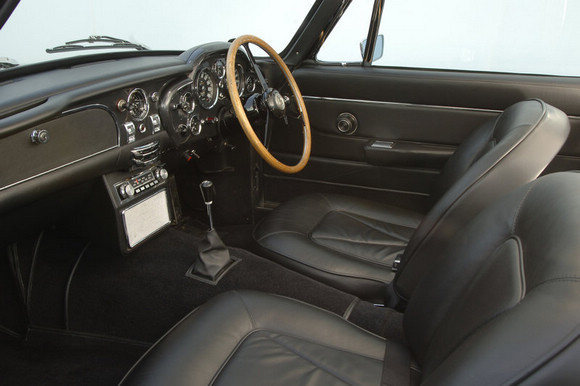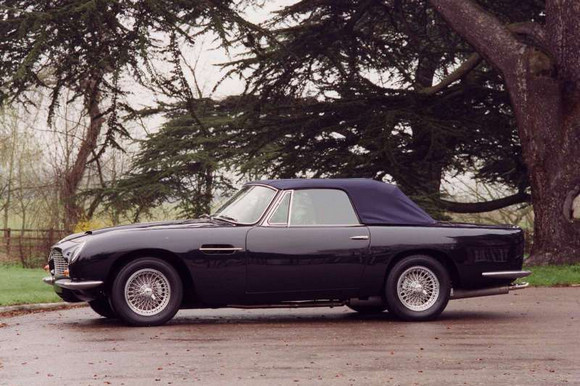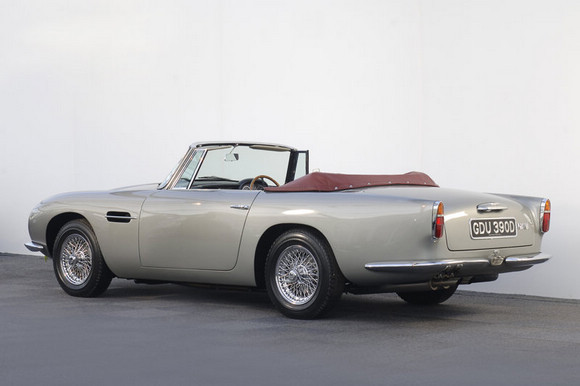The first half of aston martin, an English sports gentleman.
Similar to Italy, Britain is a country rich in sports cars and one of the origins of automobile culture. Aston Martin is one of the representatives of British cars. It is a manufacturer of luxury cars and sports cars. Aston Martin brand originated from Lionel Martin and Robert Bamford in 1913.

Aston Martin’s company is located in Newport, England, and is world-famous for producing open-top station wagons, racing cars and limited production sports cars. Aston Martin brand has always been keen on car racing. Although participating in the competition is an important means to develop car production, it was acquired by Ford Company of the United States in 1987 because of its high cost and poor management. In 2007, David Richards, the owner of Prodrive, bought Aston Martin from Ford for $925 million.
 [David Brown]
[David Brown]
Although the brand was founded as early as 1913, the Aston Martin brand became brilliant in 1947, when a man named David Brown bought the Aston Martin brand, and since then, the car series named after his initials DB has been put into production, and this tradition has been preserved. This paper lists Aston Martin’s DB cars one by one, and pays tribute to this brand dedicated to developing sports cars.
 [LOGO of Aston Martin during DAVID Brown’s holding period]
[LOGO of Aston Martin during DAVID Brown’s holding period]
1948~1950 Aston Martin DB1

Aston Martin DB1 made its debut at the London Motor Show in 1948. It is a Roadster with two doors and two seats. DB1 adopts a lightweight body design, equipped with a 2L inline four-cylinder engine, with front engine and rear wheel drive. The air intake grille style of the front of DB1 has been passed down from generation to generation, and it has become an essential element of the front face of Aston Martin.

Although it is only equipped with a 2L gasoline engine, the maximum horsepower is only 90 horsepower, but thanks to the all-aluminum body manufacturing, the body weight is only 1143kg, and the top speed of DB1 can still reach 150km/h, which is satisfactory in that year. The output of DB1 is very rare, and the total output from 1948 to 1950 was only 15 sets.
1950~1953 Aston Martin DB2

The 2-liter engine of DB1 can no longer meet people’s requirements for sports cars, so the replacement model DB2 appears. DB2 switched to an in-line 6-cylinder 2580cc gasoline engine, and adopted the very advanced DOHC design. This engine can output 105 horsepower at 5000rpm, and the maximum torque reaches 182 Nm, which is a great improvement in power compared with the previous straight-four engine.

In terms of body, DB2 has followed the design of DB1, but the wheelbase has been shortened by 9 inches, and the body of DB2 has become more compact and light. Excellent body design and compact body, when DB2′ s handling performance is unanimously affirmed by buyers.

The BD2 vantage model appeared for the first time, and Vantage represents a high-performance model in Aston Martin. The DB2 Vantage engine has been retrained, with the maximum horsepower output reaching 125 horsepower and the maximum torque reaching 195 Nm. With the body weighing 1111kg, the acceleration time of 0-96km/h is only 11.2 seconds, which is the mid-stream achievement of compact cars today, but it was indeed the super-running level in that year.

DB2′ s interior materials are also very elegant. The elements of leather and mahogany make its interior look like a luxury car of that year. This is also the consistent positioning of Aston Martin in the future, just like an elegant sports gentleman.
1951~1956 Aston Martin DB3&DB3S

DB3 is an unsuccessful model. The engine comes from DB2 Vantage, but the displacement is expanded to 2.9L and the output power is 163 horsepower. DB3 was used by Aston Martin to participate in Le Mans, but the results were disappointing.

DB3S can be regarded as a lightweight version of DB3. The reduced weight makes him more flexible in the game and enhance his fighting capacity. However, it still failed to win the title of Le Mans Competition and stepped off the historical stage in 1956. The successor of BD3S, DBR1, finally won the Le Mans trophy in 1959.
1956~1959 Aston Martin DBR1

DBR1, R is the initials of racing, and DBR1 has replaced DB3S, which has a mediocre performance in the race, and is a model for Le Mans. The DBR1 weighs only 801kg, but the final model has a 3.0L straight six-engine with a maximum output of 250 horses.

Excellent thrust-to-weight ratio and good handling performance made it finally realize its own value in 1959 and won the title of Le Mans. DBR1 is a testament to Aston Martin’s commitment to the tournament.
1957~1959 Aston Martin DB mark III

The DB MARK III can be regarded as the civilian version of the DB3 Le Mans racing car in 1951. The DB3 retired from the racing field in 1956 and was put on sale as a civilian production model in 1957. It is not much different from DB3 in engine and body. It is still a 2.9L inline six-cylinder engine, and its luxury equipment makes its car weigh 1361KG. The performance of DB MARKIII is better than that of DB2 vantage, with the acceleration time of 0-96km/h of 9.3 seconds and the top speed of 193 km/h.. MARK III produced a total of 551 vehicles.
1959~1960 Aston Martin DBR4

Like DBR1, DBR4 is a racing car, with a higher level. It is an excellent F1 racing car. It is equipped with a 2.5L straight six engine, but the power is adjusted to 280 horses, with a vehicle weight of 625kg. It is an excellent track weapon.

DBR4 failed to get excellent race results. In those days, F1 races were as strong as a cloud, such as Ferrari and Lotus. In 1960, DBR4 was replaced with a more powerful 3.0L engine, and finally got the second place in the year, which is the highest honor in DBR4′ career.
1958~1963 Aston Martin DB4

At the London Motor Show in 1958, Aston Martin released a brand-new DB4 model to replace the DB MARK III. DB4 has a larger displacement 3.7L inline six-cylinder engine, with a maximum output of 179kw(240 horsepower) and a maximum torque of 325 Nm. The maximum power of DB4Vantage model is further increased to 266 horsepower, which is significantly improved compared with the previous generation model.

In terms of vehicle weight, the weight of DB4 is reduced by more than 50kg compared with that of DB MARK III, only 1308KG. Powerful power and clean body make DB4 the first vehicle in the world to accelerate from standstill to 100 mph and then stop in less than 30 seconds. With powerful power, the speed of DB4 has also reached 224 km/h.

At that time, the DB models all had striking DB words at the rear of the car. There is no denying that the rear line of DB4 is a classic.
1963~1965 Aston Martin DB5

Aston Martin’s DB car system has gradually changed with the development and positioning of the model, from the two-seat roadster sports car of that year to a large GT suitable for long-distance driving. DB5, which came out in 1963, is such a GT.

DB5 is a very famous generation of Martin, because he became James Bond’s car in the James Bond movie. He has appeared in many 007 movies, including Goldfinger, golden eye, Die Another Day and so on.

From the appearance alone, DB2 does have a lot of classic elements. Smooth body lines and round headlights, including the air intake grille, all have a strong British style and are a beautiful two-door GT.

In terms of engine, DB5 evolved again. An inline six-cylinder engine with a displacement of 4L replaced the 3.7L engine of DB4, with a maximum power of 282 horsepower, which made the top speed of DB5 reach 233KM/H and the acceleration time from 0-97KM/H shortened to 7.1 seconds. The maximum horsepower of DB5 Vantage reaches 314 horsepower. With such performance in the 1960 s, no wonder it became an agent’s car. Compared with DB4, the vehicle weight of DB5 has greatly increased, reaching 1502kg.

The clock design above the DB5 center console was retained in the subsequent Aston models. The DB5 is equipped with a 5-speed manual gearbox from ZF, and the interior is full of luxury. This car is luxurious and full of driving pleasure.
1965~1971 Aston Martin DB6

DB6, the replacement model of DB5, was unveiled at the London Motor Show in 1965. The suspension structure of DB6 is basically the same as that of DB5, and the engine is the same 4.0L straight six engine. However, the body design of DB6 is more aerodynamic, and it is the first Aston Martin developed through wind tunnel test.

The rear of DB6 is the focus of improvement after wind tunnel test, and this fastback style is very common in sports cars in 1970s. The wheelbase of DB6 is 95mm longer than that of DB5, which makes it more excellent in high-speed stability, but the disadvantage is that it brings a bigger body. However, the vehicle weight of DB6 is slightly reduced compared with that of DB5, which is 1474kg.

The profile of DB6 can be described as reaching the peak of GT model in 1960s, with perfect and smooth proportion, which is a model of fastback style.
 [The interior of DB6 is almost the same as that of DB5]
[The interior of DB6 is almost the same as that of DB5]
 [The convertible DB6 volante is also available, which is a roadster]
[The convertible DB6 volante is also available, which is a roadster]

The DB6 volante SWB in the above picture is actually a derivative model based on the DB5 chassis, because the wheelbase of DB5 is 94mm shorter than that of DB6, and SWB is short Wheelbase. DB6 volante SWB is more flexible than DB6 volante, which is more in line with roadster’s positioning.
1967~1972 Aston Martin DBS

DBS, which was born in 1967, is the successor model of DB6. Compared with DB6, DBS has grown again, with a wheelbase of 2610mm, a vehicle length of 4585mm and a vehicle weight of 1590kg.

Although DBS still retains the appearance of double doors and quick backs, in fact, the internal space can accommodate four adults comfortably. In addition to a 4.0L inline six-cylinder engine from BD6, DBS also offers a V8 engine model, which is the first model equipped with V8 engine in Aston Martin’s history.

This V8 engine has a displacement of 5.3L, and adopts a fuel injection system from Bosch, with a maximum power of 315 horsepower. The powerful power shortens the acceleration time of DBS 0-97 km to 5.9 seconds and the top speed reaches 257 km/h..

There is no difference between DBS V8 and DBS body, but the ZF gearbox which can withstand higher torque and wider tires are used, and the larger engine and stronger gearbox all bring about the weight increase, and the DBS V8 car weighs an astonishing 1820kg. Look at his performance in the corner. Although he has strong power, the excessive weight of the car makes him clumsy.

DBS is the last model of DAVID Brown’s holding era. After 1972, the Aston Martin brand changed hands with William Wilson. David Brown Company has achieved the Aston Martin brand and written a glorious page of the Aston Martin brand. The David Brown period can be described as the first half of the Aston Martin brand.